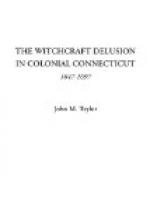[Footnote D: Fifty-five persons suffered torture, and twenty were executed before the delusion ended. Ency. Americana (Vol. 16, “Witchcraft").]
Upham in his Salem Witchcraft (Vol. II. pp. 249-250) thus pictures the situation.
“The prisons in Salem, Ipswich, Boston, and Cambridge, were crowded. All the securities of society were dissolved. Every man’s life was at the mercy of every man. Fear sat on every countenance, terror and distress were in all hearts, silence pervaded the streets; all who could, quit the country; business was at a stand; a conviction sunk into the minds of men, that a dark and infernal confederacy had got foot-hold in the land, threatening to overthrow and extirpate religion and morality, and establish the kingdom of the Prince of darkness in a country which had been dedicated, by the prayers and tears and sufferings of its pious fathers, to the Church of Christ and the service and worship of the true God. The feeling, dismal and horrible indeed, became general, that the providence of God was removed from them; that Satan was let loose, and he and his confederates had free and unrestrained power to go to and fro, torturing and destroying whomever he willed.”
The trials were held by a Special Court, consisting of William Stoughton, Peter Sergeant, Nath. Saltonstall, Wait Winthrop, Bartho’ Gedney, John Richards, Saml. Sewall, John Hathorne, Tho. Newton, and Jonathan Corwin,—not one of them a lawyer.
Whatever his associates may have thought of their ways of doing God’s service, after the tragedy was over, Sewall, one of the most zealous of the justices, made a public confession of his errors before the congregation of the Old South Church, January 14, 1697. Were the agonizing groans of poor old Giles Corey, pressed to death under planks weighted with stones, or the prayers of the saintly Burroughs ringing in his ears?
“The conduct of Judge Sewall claims our particular admiration. He observed annually in private a day of humiliation and prayer, during the remainder of his life, to keep fresh in his mind a sense of repentance and sorrow for the part he bore in the trials. On the day of the general fast, he arose in the place where he was accustomed to worship, the old South, in Boston, and in the presence of the great assembly, handed up to the pulpit a written confession, acknowledging the error into which he had been led, praying for the forgiveness of God and his people, and concluding with a request, to all the congregation to unite with him in devout supplication, that it might not bring down the displeasure of the Most High upon his country, his family, or himself. He remained standing during the public reading of the paper. This was an act of true manliness and dignity of soul.” (Upham’s Salem Witchcraft, Vol. II, p. 441).
Grim, stern, narrow as he was, this man in his self-judgment commands the respect of all true men.




